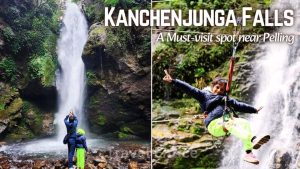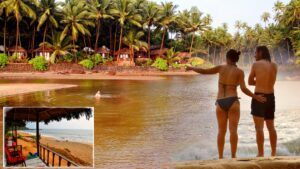Are you looking for an escape into breathtaking mountain vistas, spiritual serenity, and a true sense of adventure? Welcome to Ladakh—India’s high-altitude Himalayan paradise, where every turn unveils majestic mountains, pristine rivers, and ancient culture. Let’s explore the best places to visit in Ladakh, the ideal time to visit, and a perfect Ladakh Itinerary for your upcoming trip.
Ladakh, the “Land of High Passes,” is where barren mountain beauty meets vibrant Tibetan culture. Unlike the rest of India, which experiences heavy rainfall in July-September, Ladakh lies in a rain shadow region and remains mostly dry during monsoon. That makes it an ideal escape when the rest of the country is soaked. In fact, Ladakh is one of the best places to visit in Asia in August-September.
In this Ladakh Travel Guide, we explore the top tourist destinations in Ladakh and give you a customizable itinerary starting from Srinagar Airport, covering Drass, Kargil, Lamayuru, Nubra Valley, Pangong Lake, Hanle, and Zanskar Valley. Also, you can choose the start your journey from Leh Airport.
Related Article: Top 12 Safe Monsoon Destinations in India
Table of Contents
Best Places to Visit in Ladakh
This Ladakh travel guide starts from Srinagar Airport, making it easier to explore destinations like Drass and Kargil before gradually moving toward deeper parts of Ladakh such as Nubra, Pangong, Hanle, and Zanskar. Here’s your detailed look into the 6 best places to visit in Ladakh, each offering a distinct flavor of adventure, beauty, and peace.
Drass – India’s Coldest Inhabited Town
If you are entering Ladakh through Srinagar, Drass will be your first introduction to the region. Sitting at an altitude of 10,990 feet, this quaint town is famously known as India’s coldest inhabited place, with winter temperatures plummeting to -45°C. But in summer, Drass transforms into a poetic landscape—green valleys, crystal-clear streams, and snow-capped peaks in the distance.
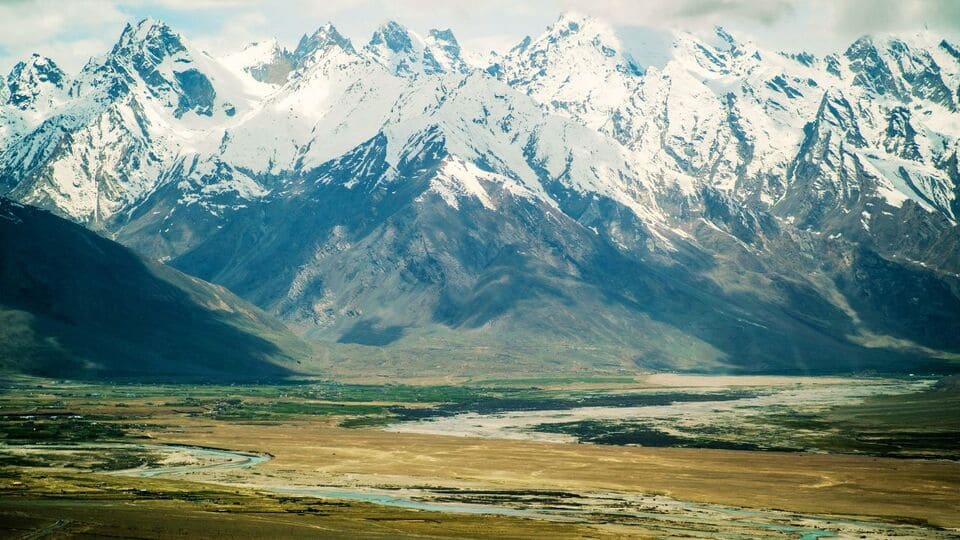
The calm Drass River meanders through the town, and places like Draupadi Kund offer moments of reflection in nature’s lap. Not far lies Matayen, one of the few villages where the Shina-speaking Dard people reside, giving visitors a glimpse into a unique culture. History buffs will appreciate the Kargil War Memorial, located just 10 km from Drass. This site honors the bravery of Indian soldiers and provides a panoramic view of Tiger Hill and Tololing, the key battle sites during the 1999 conflict.
For trekkers, Drass and Kargil offer thrilling trails through pristine terrain, such as Suru Valley trek and others.
Must-visit spots:
- Drass War Memorial
- Draupadi Kund
- Matayen Village
- Nearby Kargil with Suru Valley, Tiger Hill, and monasteries
📍 Srinagar Airport: 155 km | Leh Airport: 277 km
Lamayuru – The Moonland of Ladakh
Lamayuru is not just a village; it’s a geological marvel. Located between Kargil and Leh, this serene spot is often referred to as the ‘Moonland of Ladakh’ for its surreal, cratered landscape. Legend has it that Lamayuru was once submerged under a vast lake, which dried up over centuries, leaving behind eroded hills and peculiar rock formations that appear otherworldly—especially under moonlight.

The centerpiece of Lamayuru is its ancient monastery, believed to be one of the oldest and most revered in Ladakh. Set dramatically on a hilltop, the monastery offers a stunning view of the surrounding lunar terrain.
The village itself is peaceful, home to a few guesthouses and homestays where you can experience the simplicity of Ladakhi life. Just a short drive away are other scenic and spiritual spots like Alchi Monastery, Sham Valley, and Uleytokpo—ideal for those seeking solitude and spiritual depth.
The blend of eerie natural formations and deep-rooted Tibetan Buddhist traditions make Lamayuru unique. It’s one of the most photogenic and meditative stops on the Ladakh circuit.
Top attractions:
- Lamayuru Monastery (one of the oldest in Ladakh)
- Alchi Monastery, Sham Valley, Uleytokpo, and Yurutse village
📍 Srinagar Airport: 355 km | Leh Airport: 111 km
Nubra Valley – A Desert Between Mountains
Hidden beyond the mighty Khardung La Pass, the Nubra Valley reveals a surprising world— flowing rivers, green oases, sand dunes, and high-altitude deserts all rolled into one.
As you descend from the high pass, the valley opens up with spectacular contrasts: golden sands of Hunder on one side and lush, cultivated fields along the Shyok and Nubra rivers on the other.
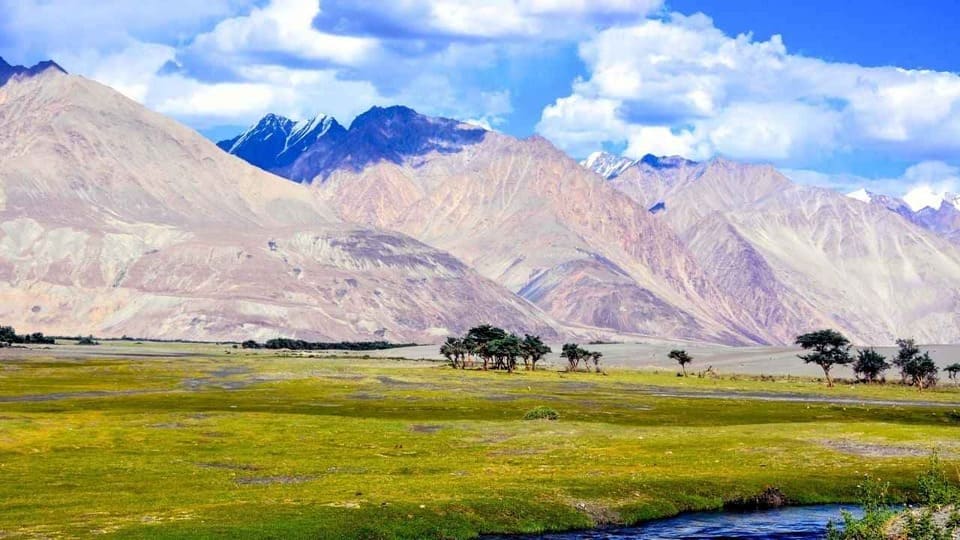
Nubra is not just about landscapes; it’s about experiences. You can ride a double-humped Bactrian camel across the cold desert of Hunder, or soak in the healing waters of Panamik hot springs. Diskit, the largest town in the valley, is home to the iconic Diskit Monastery, which offers panoramic views and hosts a massive statue of Maitreya Buddha.
Further north, the village of Turtuk—once part of Pakistan—stands as a cultural gem. Its Balti heritage, apricot orchards, and narrow alleys make it an unforgettable destination. For those seeking peace, Yarab Tso (Lake), hidden behind the dunes, is perfect for quiet reflection.
Despite being so remote, Nubra feels alive. It’s a valley of contrasts—where winter and summer, desert and river, old and new coexist in harmony. Spending at least three days here is recommended to fully soak in its diverse beauty.
Top places to visit:
- Hunder Sand Dunes & Camel Safari
- Diskit Monastery
- Panamik Hot Springs
- Turtuk Village (a beautiful border town)
- Yarab Tso Lake
📍 Srinagar Airport: 590 km | Leh Airport: 163 km
Pangong Tso – A Living Canvas of Blue
If there’s one image that defines Ladakh on travel brochures and Instagram or YouTube, it’s the deep blue waters of Pangong Lake. Stretching over 150 kilometers and reaching into China, Pangong Tso sits at a staggering 14,270 feet above sea level. What mesmerizes visitors is the lake’s changing colors—turquoise in the morning, cobalt by noon, and grey-blue by dusk.
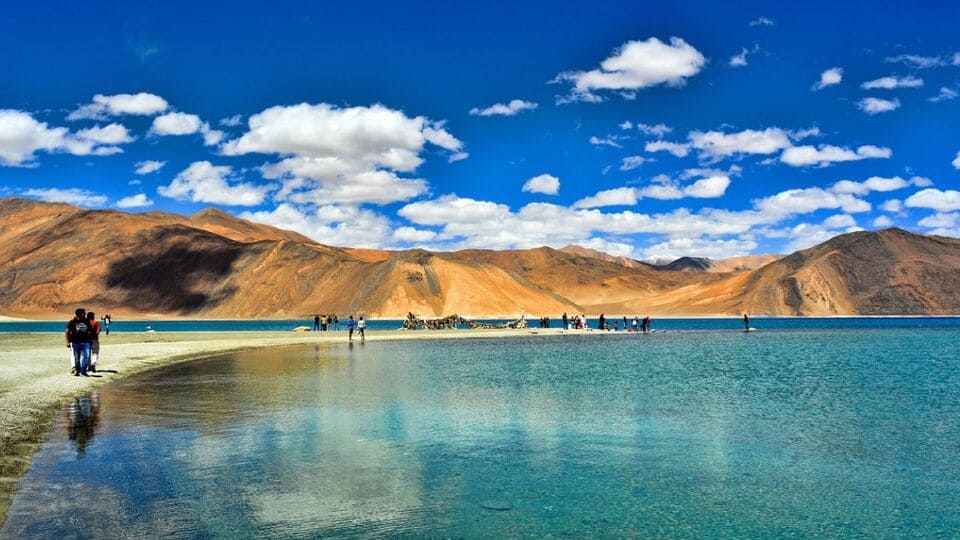
However, Pangong is not just about visuals. The journey to the lake, via the dramatic Chang La Pass, is a story in itself. Along the way, you’ll pass through quaint villages, military check-posts, and open plains dotted with yaks and marmots. At the lake, Spangmik village serves as the main campsite, where you can stay in cozy tents with picture-perfect views.
Beyond photography and stargazing, Pangong offers a deep sense of stillness. The lake’s mirror-like surface reflects the silence of the surrounding mountains. Nearby monasteries like Thiksey, Hemis, and Chemrey can be visited en route, adding spiritual richness to your journey.
Things to do:
- Camping at Spangmik
- Visit nearby Chang La Pass
- Spot marmots & migratory birds
- Extend your trip to Hemis, Thiksey, Chemrey Monasteries
Pangong is the kind of place that leaves a mark. No matter how many lakes you’ve seen, this one stays with you forever—in your eyes, your memory, and your heart.
📍 Srinagar Airport: 650 km | Leh Airport: 225 km
Hanle – Under a Blanket of Stars
Far removed from the typical tourist trail, Hanle is a sanctuary for solitude seekers and astronomy lovers. Located near the Line of Actual Control (LAC) in eastern Ladakh, Hanle is home to the Indian Astronomical Observatory, one of the world’s highest and most remote telescopes. With almost zero light pollution, Hanle offers perhaps the clearest night skies in Asia.
The journey to Hanle from Pangong or Tso Moriri is an adventure through vast plateaus, grasslands, and dramatic mountain ranges. The landscape is wide open, with rolling meadows and scattered mountain peaks under an endless sky.

Apart from the observatory, Hanle boasts the beautiful Hanle Monastery, perched on a hill overlooking the valley. You can also visit the Kyun Tso and Ryul Tso (lakes), twin water bodies known for their vivid colors and tranquil surroundings.
Umling La Pass, the world’s highest motorable road, lies not far from Hanle and is an optional detour for the brave-hearted.
Hanle isn’t just a destination—it’s a feeling. It’s the moment when you lie down under the stars, in complete silence, and realize how vast and beautiful the universe truly is.
Highlights:
- Indian Astronomical Observatory
- Hanle Monastery
- Umling La (world’s highest motorable road)
- Twin lakes: Kyon Tso (Chilling Tso & Ryul Tso)
📍 Srinagar Airport: 740 km | Leh Airport: 313 km
Zanskar Valley – The Hidden Gem of Ladakh
Tucked deep within the Himalayan folds, Zanskar Valley is Ladakh’s most remote and mystical region. Isolated until the late 1990s, this valley remains untouched by mass tourism, offering a glimpse into Ladakh’s ancient soul. Surrounded by towering peaks, deep gorges, and roaring rivers, Zanskar is where nature reigns supreme.
The mighty Zanskar River, a tributary of the Indus, slices through the valley, creating dramatic canyons that attract adventurers and photographers alike. During winter, the river freezes to form the famous Chadar Trek, one of the most unique trekking experiences in the world. In summer, the river is ideal for white-water rafting and riverside picnics (though not happens due to offbeat loction).
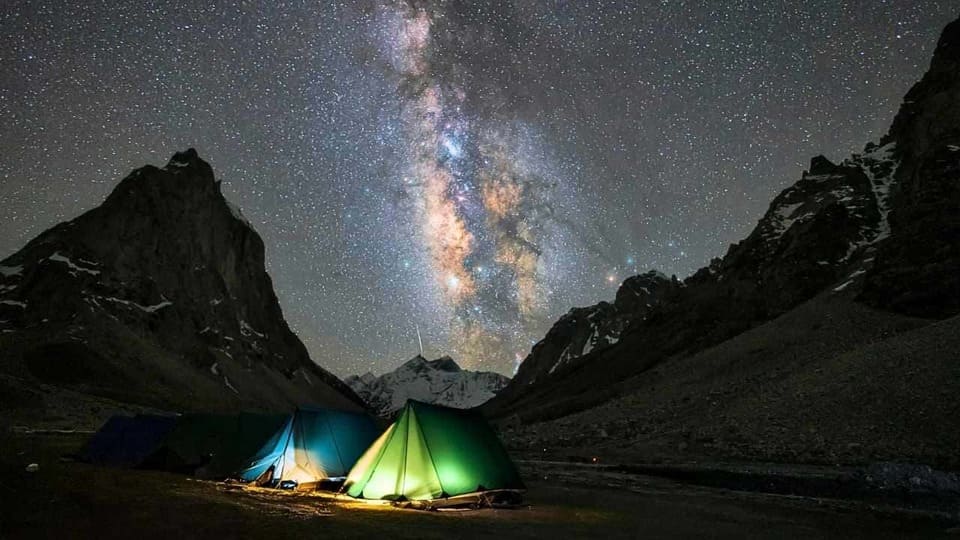
Zanskar is also a spiritual retreat. Monasteries like Karsha, Stongdey, and Phugtal, often built into cliff faces, are inhabited by monks who live lives of quiet devotion. The villages here—simple, hospitable, and often cut off for months in winter—showcase the resilience of life at high altitude.
For those willing to go off the beaten path, Zanskar is the ultimate reward. It demands time, patience, and preparation, but gives back an experience that is raw, powerful, and deeply humbling.
Must-visits:
- Shafat Glacier
- Lang Tso & Ta Tso lakes
- Pensi La Pass
- Ancient monasteries (Karsha, Stongdey)
📍 Srinagar Airport: 427 km | Leh Airport: 58 km
Other Things to Do in Ladakh
- Visit Magnetic Hill – experience the optical illusion
- Explore Sangam Point – confluence of Indus and Zanskar Rivers
- Camp near Tso Moriri and Tso Kar
- Attend Hemis Festival, Ladakh Festival, or Losar
- Try camel/yak safaris, river rafting, or short treks
- Visit Royal Leh Palace, Shanti Stupa, Shey & Spituk Monastery
Related: Safe and Cool Summer Destinations in India
Suggested Ladakh Tour Plan
A trip to Ladakh is best experienced when planned wisely. If you are entering via Srinagar Airport, consider this ideal route:
✅ Ladakh Itinerary Option 1 (15–16 Days)
Drass (1N) → Kargil (1N) → Lamayuru (1N) → Nubra Valley (3N) → Pangong Lake (1-2N) → Hanle (2N) → Zanskar Valley (3N) → Return to Leh
| Day 1 | Arrive in Srinagar → Drive to Drass and Kargil |
| Day 2 | Drass Sightseeing→Drass to Kargil |
| Day 3 | Kargil Sightseeing and Stay in Kargil |
| Day 4 | Kargil to Lamayuru |
| Day 5 | Lamayuru to Nubra Valley via Khardung La |
| Day 6-7 | Nubra Valley Sightseeing & Sand Dunes |
| Day 8 | Nubra Valley to Pangong Lake |
| Day 9 | Pangong Lake (rest day) |
| Day 10-11 | Hanle Sightseeing and rest |
| Day 12 | Hanle to Leh |
| Day 13 | Leh to Zanskar Valley (via Rangdum) |
| Day 14-15 | Zanskar Valley |
| Day 16 | Return to Leh for departure |
If you want to include Tso Moriri, then extend your trip for another 2-3 days.
This itinerary balances altitude gain, scenic diversity, and cultural exploration. Make sure to carry Inner Line Permits (ILPs) for visiting restricted areas like Nubra, Pangong, and Hanle.
Note: Zanskar Valley is off-route. You may cover it before or after the Nubra–Pangong–Hanle leg if time permits.
✅ Ladakh Itinerary Option 2 (Shorter Version – 7-8 Days)
Zanskar Valley lies in a completely different direction, and Hanle is located quite far from the main tourist circuit. So, if you’re planning a shorter trip, it’s practical to skip both.
Similarly, if you’re arriving via Leh airport, you may consider excluding Drass and Kargil from your Ladakh itinerary. These two towns are situated far from Leh and in the opposite direction of most popular Ladakh attractions like Nubra Valley, Pangong Lake, and the sand dunes.
Leh →Lamayuru (1N) → Nubra Valley & Sand Dunes (3N) → Pangong Tso (2N) → Leh
How to Reach Ladakh
- By Air: Direct flights to Leh Airport (Kushok Bakula Rimpochee Airport) from Delhi, Mumbai, etc.
- By Road from Srinagar Airport: Best scenic route; includes night halt at Drass and Kargil.
- By Road from Manali: Adventurous option (474 km); plan for 2 days with halt at Jispa or Sarchu.
Also Read: 9 Coolest Himalayan Hill Stations – Where Summer Feels Like Winter
Best Time to Visit Ladakh
From May to October, the region becomes fully accessible, with June to August being the ideal time for a Ladakh road trip.
During these months, all mountain passes open up, making remote valleys and lakes reachable without restriction. While the rest of India is drenched in monsoon rains, Ladakh stays dry—offering clear skies and inviting weather with daytime temperatures ranging from 15°C to 25°C.
Where to Stay in Ladakh
Below we have introduced a list of the best hotels in Ladakh’s different tourist places. This may help you to find your favorites.
| Drass: | Mount View Homestay, Grand Snow Land, Hotel D’Meadows, Snow crust (Matayen) |
| Kargil: | The White Castle, Rangyul Resort, Hotel The Kargil, Black Sheep, Chutuk Heights, The Haven Kargil, Ashuna Village Resort |
| Leh: | Sangaylay Palace, Bodhi Tree Hotel, Ladakh Country Inn, Orion Home, Palay Shay, Ladakh Residency, Heschuk Guest House, Hotel Trikaya, The Grand Dragon Ladakh |
| Lamayuru: | Siachen Guest House, Amchi Guest House, Hotel moonland, Dragon Hotel |
| Nubra: | Lzawa Residency, Organic Boutique Hunder, The Crystal Resort, Karma Inn, White Sands Resort, Nubra Organic Retreat, Dunes Boutique Hotel, The Kyagar, Lchang Nang Retreat, Stone Hedge |
| Pangong: | Star Quest Cottages, Misty Hills Cabins, Pangong Nest, SAMA resort, Crystal Lake Resort, Grand Cottage Pangong, Snow Pine, Aspire Ladakh |
| Hanle: | Ruthpa Homestay, Holiday Inn Hanley, Padma Homestay, Umlingla Residency, Hanle House, Aurora Cabin |
| Zanskar: | Konka guest house, Padum paradise, Marc Guest House, Zanskar Eco Lodge, Namkha Resort, Guru View Homestay, Shingkula Tents, Hotel Rigyal |
Travel Tips for Ladakh
- Acclimatize for 24–48 hours in Leh/Kargil before high-altitude travel.
- Always carry ID proof and Inner Line Permits (ILPs) for Nubra, Pangong, and Hanle.
- Carry woolens even in summer; nights are cold.
- Mobile networks work mainly in Leh (Jio/BSNL only). No guaranty in other places.
You may find interesting: 12 Best Places to Visit in Pelling – Top Attractions & Travel Guide
Final Words: Best Places to Visit in Ladakh
Ladakh is not a place you simply visit. It’s a place you feel, breathe, and absorb. Whether it’s the surreal landscape of Lamayuru, the cosmic silence of Hanle, or the spiritual calm of Zanskar’s monasteries—each destination in Ladakh offers something unforgettable. It stands proudly among the best places to visit in Asia in August, especially for those seeking a summer road trip with soul.
Ready to witness heaven on Earth?
Ladakh awaits you.
Dr. Suvankar Das is a scientific advisor by profession, associated with a CRO organization. He pursued his doctoral degree in Chemistry in 2015. Later, he worked as a postdoctoral researcher & scientist in a couple of institutes/companies.
Besides his scientific journey, Dr. Das is also a passionate traveler and travel blogger. He loves to share all his travel experiences with other travelers so that everyone can enjoy hassle-free holidays with their own tour plans.
He believes, the most beautiful thing in this world is the WORLD itself. so there is no way to live like a clock; rather live it like a compass!

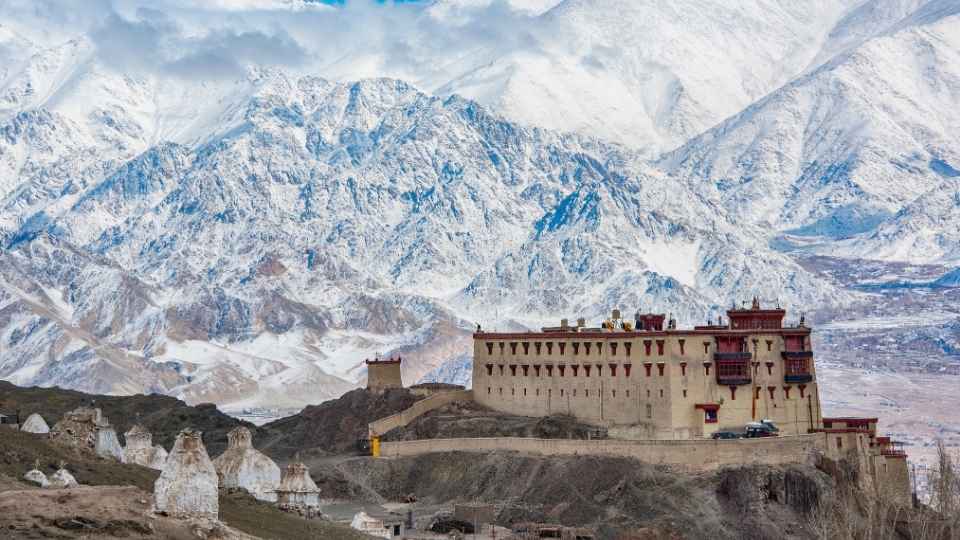
![Gumbadara Viewpoint: Enjoy a Breathtaking Panoramic View of Mountain Valley [& Mt. Kanchanjungha] 9 Read more about the article Gumbadara Viewpoint: Enjoy a Breathtaking Panoramic View of Mountain Valley [& Mt. Kanchanjungha]](https://travelentice.com/wp-content/uploads/2023/06/Gumbadara-Viewpoint-300x169.jpg)
